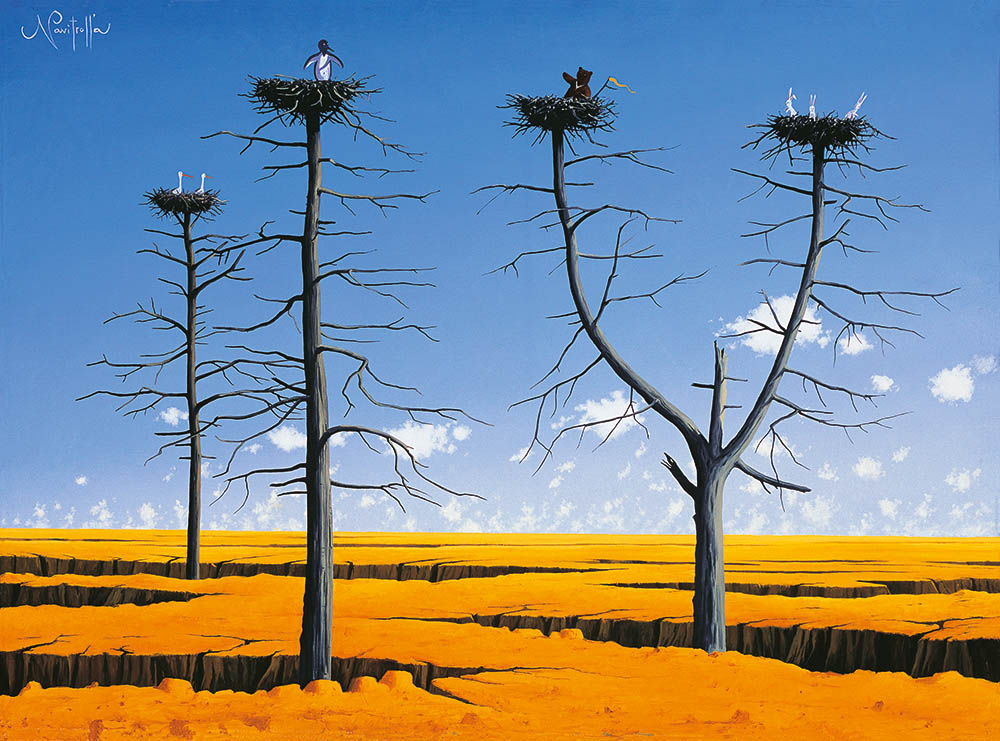But with the paintings of the Estonian artist Navitrolla, locales like these are merely the spark that trigger a larger explosion of visual ideas.
Sure, within his paintings, there is a fairly consistent backdrop of green meadows, tufts of evergreen trees, and sprinklings of rusty yellow, blue, and white wildflowers. The skies fade into clear, optimistic blues, with shreds of white clouds floating freely. There is so much open space to frame these scenes, and so you do really feel like you've stepped into the Estonian countryside. You can feel the gravel road underneath the soles of your shoes. On the side of the road are the tire tracks of a farmer's tractor and a pile of timber stacked up against a field of growing crops.
In his paintings, Navitrolla, whose birth name is Heiki Trolla, would appear to be sourcing scenery from the place he grew up in Navi, Võru County.
However, into these views, he also throws in dreamlike inversions of reality.
His painting “Kana on kuningas” (“Chicken is King”) shows a hen facing off against two curious foxes in the foreground, while a giant egg looms above them. The weight of the egg is emphasized by the heavy shadow it casts. The foxes may get the hen momentarily, but soon the egg will hatch and the chick that comes out will show its dominance.
Similarly, “Kui kogu maailma seened ühineksid” (“If All the Mushrooms In the World Would Unite”) shows a colossal yellow capped mushroom with a stipe as thick as a cluster of redwoods. A comparatively tiny dog stands below at the edge of the field, barking at the mushroom. Navitrolla augments the typically calm feeling of these countryside landscapes and gives them an edge of ferocity. It's unclear what this mushroom is capable of.
Other works of his start to veer more towards animals and landscapes beyond Estonia. “Peidus” (“Hiding”) transports a giraffe from the African savannah, which is camouflaged against the patterned bark of birch trees. “High as a Kite” also features a giraffe, this time poking it's neck through one of the clouds floating by.
One of the most different paintings he has made is “Kuidas ületada lõhe meie vahel?” (“How to Bridge the Gap Between Us?”), where an expansive desert is divided by a deep rift in the ground. On one side is a friendly-looking domesticated dog, and on the other side is an unidentifiable, shadowy canine. Its mouth is open, as though it's exhausted, dehydrated, and breathing heavily.
He brings it all back together conceptually with “Väike valearvestus” (“A Small Miscalculation”). In a similar desert location, sparse and skeletal trees emerge from three different cavernous cracks in the ground. Against the blue sky, the trees are topped with stick nests like those built by storks. The kind that you'd see driving around in rural Estonia. Except, inside three of the nests are a penguin, a bear, and a group of white rabbits. They call out to each other and look down to the ground, assessing the best way back down.
These are peculiar worlds, and yet, there is something familiar about them. Navitrolla describes his work as combining naïvism and surrealism, though I would lean more towards the latter classification, because of their ability to accurately capture the complex way our minds exaggerate and change what we see when we are awake. That's not a simple undertaking.
Lembi Randma, Office Director at Navitrolla United Factories (where one can view the artist's works in Tallinn), has attested to how, “As the viewers approach his paintings, they walk into his world…the paintings start to talk…” Randma adds that “[Navitrolla] makes you dream…”
Above all, Navitrolla is a master of fusing together visual trademarks of far away landscapes and thereby making the surreal feel totally possible, familiar, and even desirable.
Written by Vincent Teetsov, Toronto




